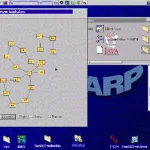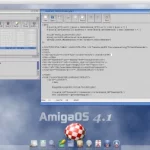Web site: (not active)
Origin: USA
Category: Desktop
Desktop environment: Workplace Shell
Architecture: PowerPC
Based on: Independent
Wikipedia: Workplace OS
Media: Install
The last version | Released: 1.0 | January 5, 1996
Workplace OS – an IBM project which unsuccessfully attempted to replace multiple operating systems with compatibility “personalities” running on top of a Mach-based microkernel.
The intention was that personalities would allow a single machine to run unmodified applications from multiple operating systems such as Unix or OS/2. It was the product of a research program in 1991 which yielded a design named the “Grand Unifying Theory of Systems “(GUTS). The GUTS project evolved into Workplace OS after Apple demonstrated its Pink operating system prototype to IBM’s GUTS design team, who incorporated many ideas from Pink into their own design.
Workplace OS was intended to improve software portability and maintenance costs by recruiting all operating system vendors to convert their products into Workplace OS personalities. That included Pink when it became Taligent, which was co-developed with Workplace OS. In 1995, IBM reported that “Nearly 20 corporations, universities, and research institutes worldwide have licensed the microkernel, laying the foundation for a completely open microkernel standard.” Workplace OS was at the core of IBM’s new strategic direction for the entire company, and was intended as the primary operating system for PowerPC hardware, to allow IBM to effectively compete with the Wintel duopoly.
With protracted development spanning four years and $2 billion (or 0.6% of IBM’s revenue for that period), the project suffered development hell characterized by workplace politics, feature creep, and the second-system effect. Many idealistic key assumptions made by IBM architects about software complexity and system performance were never tested until far too late in development, then immediately proven infeasible. In January 1996, the first and only preview of Workplace OS was released under the OS/2 family with the name “OS/2 Warp Connect (PowerPC Edition)”. It was limited to special order by select IBM customers, and had limited functionality compared with the original OS/2 for x86. The entire Workplace OS platform was discontinued in March due to very low market demand, including that for enterprise PowerPC hardware.
A University of California case study described Workplace OS as both “one of the most significant operating systems software investments of all time” and “one of the largest operating system failures in modern times”.
The Workplace OS project was finally canceled in March 1996 due to myriad factors: inadequate performance; low acceptance of the PowerPC Reference Platform; poor quality of the PowerPC 620 launch; extensive cost overruns; lack of AIX, Windows, or OS/400 personalities; and the overall low customer demand. The only mainstream desktop operating system running on PowerPC was Windows NT, which also lacked supply and demand. Industry analysts said that “the industry may have passed by the PowerPC”. In 1996, IBM also closed the Power Personal Division responsible for personal PowerPC systems. IBM stopped developing new operating systems, and instead committed heavily to Linux, Java, and some Windows. In 2012, IBM described Linux as the “universal platform”.
Source: Wikipedia; License: Creative Commons Attribution-ShareAlike 4.0 International.




